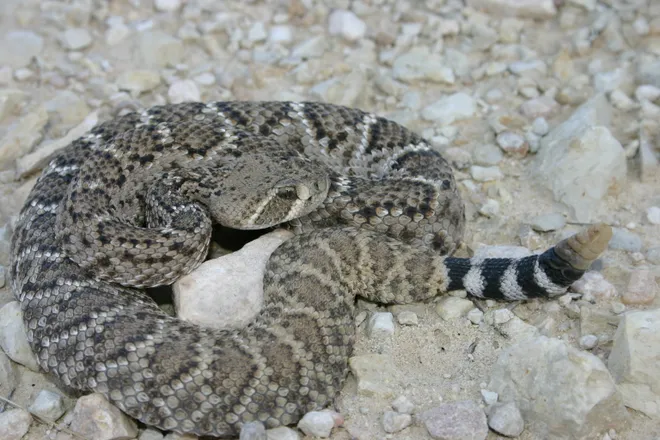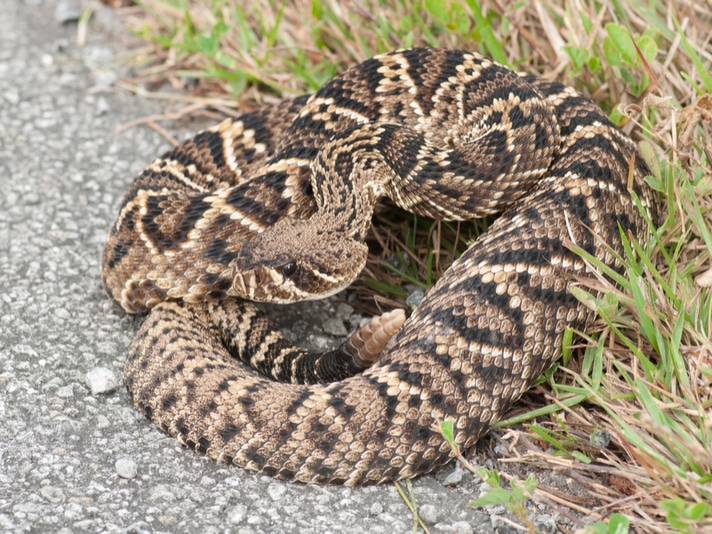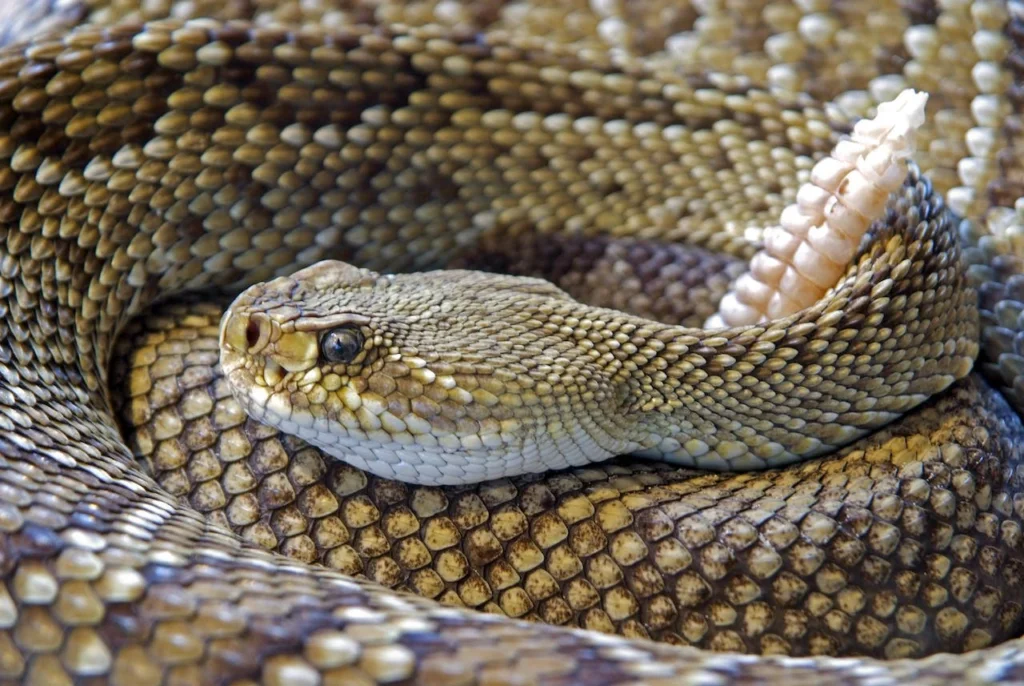
Welcome to the captivating world of rattlesnakes and their intriguing rattlesnake bites! Rattlesnakes are a group of venomous snakes that have fascinated humans for centuries. One of their most distinctive features is their rattle, a unique adaptation that sets them apart from other snakes. But what exactly is the purpose of this buzz rattling sound? Let's dive into the mesmerizing realm of rattlesnake biology and behavior to understand the enigma behind how rattlesnakes live.
We are going to explore a lot of topics, myths, and much more. After finishing this article, you will be able to know that the rattles on a rattlesnake don't tell you much about the age, only give you an approximate estimation about it. You will also discover how they look, what they eat, and most important, some advice if you get into rattlesnake territory.

But first, what does a rattlesnake sound like? A rattlesnake's sound is like a blend of a shaking maraca and a hiss. When it feels threatened, it uses its unique tail rattle, composed of hollow segments, to make a rattling noise. This warns potential predators to back off, and the hissing sound that accompanies it adds to the intimidating effect. It's a distinct and cautionary sound that helps keep other animals and curious humans at a safe distance!
At first glance, the rattlesnake's rattle may seem like mere loud noise, but why does a rattlesnake rattle? This rattling sound is not just a warning to warn potential aggressors, predators or threats but also a vital form of communication within their social structure. By unraveling the true significance of this auditory marvel, we'll gain a profound appreciation for the role these rattlesnake rattle play in the lives of rattlesnakes.
Have you ever wondered how do rattlesnakes rattles make that famous sound? Commonly, a lot of people could think that the inside of the rattle could have a little thing that, when the snake shakes it produces their popular sound, but no. The answer is in their tail, where there's room for movement, allowing them to wiggle freely. When the rattlesnake shakes its tail, those hollow segments collide with one another, producing the distinct rattling sound we associate with these serpents. This is the mechanism behind the rattlesnake's rattle in action.
Rattlesnakes are some of the most intriguing and feared creatures in the animal kingdom. Their distinctive rattle and venomous bite have earned them a reputation as formidable predators. However, there's much more to these serpents than meets the eye. In this quick overview, we'll explore some essential facts about rattlesnakes to help you better understand and appreciate these fascinating reptiles.
Rattlesnakes come in various species, each with its own unique characteristics. Some of the common rattlesnakes that can be found in North and south America area include western diamondback rattlesnakes, timber rattlesnakes, and Mojave rattlesnakes.
Generally, they have stout body with a distinctive triangular-shaped head. Their eyes have vertical pupils, providing them with excellent vision, especially in low light. Rattlesnake scales are keeled, giving them a rough appearance. They are beautifully patterned with a series of dark, diamond-shaped blotches along their back, varying in color and arrangement depending on the species.
Rattlesnakes play a vital role in their ecosystems as top predators. They primarily prey on rodents like mice and rats, helping to control their populations.
By doing so, rattlesnakes help maintain a balance in the food chain and prevent an explosion of rodent numbers that could otherwise devastate plant life and disrupt other animal populations.
The answer is no, they will be growing and gaining rattles with time, but this leads us to an important question, what does the number of rattles on a rattlesnake mean? Well, this doesn't have a specific meaning, but can help us, with other elements, to get information about the age of the snake.
The iconic timber rattlesnake rattle is a fascinating feature that sets these serpents apart from other snakes. Contrary to popular belief, the timber rattlesnake and rarely' rattle is not a single structure but rather a collection of segments with unique properties. Let's delve into the anatomy of new segments of a rattlesnake's rattle to understand its composition and function.

The rattlesnake's rattle is an extraordinary structure made up of a series of hollow, interlocking segments. These segments are composed of keratin, the same material found in our fingernails and hair. But how can you tell the age of a rattlesnake? With each shedding of their skin, a new segment is added to the snake' rattle, making it a unique record of the rattlesnake's growth and age.
When a rattlesnake shakes its tail, the hollow segments of the snake's venom and rattle collide, creating that characteristic rattling sound wave. As the snake grows and the rattlesnake shed its skin, the venom and rattle increase in size, and the number of hollow chamber segments grows, offering an approximate indicator of the rattlesnake's age.
Some rattlesnakes are born without rattles, so they have to rely on their stealthy snake skills instead. Just like a ninja, they use their keen senses to sneak around quietly. So, if you ever spot a rattlesnake without rattles, remember, that it's like a silent superhero of the snake world, relying on its smooth moves to stay mysterious!
The rattlesnake's tail rattle is more than just a unique feature; it serves critical functions in the snake's life and plays a crucial role in its survival. Let's explore the various functions and uses of the rattlesnake rattle.
The rattlesnake the snake's tail rattle, is a vital survival tool. When a rattlesnake feels threatened, it rapidly vibrate its tail, producing that distinctive rattling sound. This serves as a warning to other potential aggressors, predators or intruders, letting them know that the snake is prepared to defend itself. It's like saying, "Stay away from me!" to give others a chance to back off.
Rattlesnakes possess an impressive ability to control the intensity and speed of their rattling. When confronted by a larger predator, they may produce a more intense and aggressive rattle, warning the threat to stay away.
On the other hand, when faced with a smaller, less threatening animal, they may produce a softer, less alarming rattle to avoid wasting unnecessary energy. This sonic defense is a clever adaptation that helps rattlesnakes navigate their environment while conserving precious resources.

The sound of a rattlesnake's rattle is truly fascinating and can send shivers down your spine. It's often described as an eerie, buzzing noise. The rapid movement of the animals' tails through the hollow segments creates this unique sound, which can vary in pitch and intensity depending on the rattlesnake's size and the speed at opposite direction in which it shake its tail.
The rattling sound of a rattlesnake serves not only as a warning to the predator and potential threats but also as camouflage and a form of communication with other rattlesnakes. They can use startling sound of their rattles to establish territories or communicate with potential mates during the breeding season. Some small animals in their habitat have learned to recognize and hear this distinctive sound, allowing them to avoid the rattlesnake and stay safe.
Rattlesnakes have been the subject of various myths and misconceptions throughout history. Some myths suggest that rattlesnakes are aggressive and attack without warning, even when bitten after losing their rattles. However, these misconceptions often arise from misunderstandings about their behavior and the true purpose of their rattles.
In reality, rattlesnakes are not aggressive by nature and would rather avoid confrontation if possible. Their rattles serve as camouflage and a warning mechanism to prevent conflicts, not provoke them. Understanding the true function of rattlesnake and timber rattlesnake, can help dispel these misconceptions and foster a more accurate perception of these fascinating reptiles.
When venturing into rattlesnake territory, including timber rattlesnake and mojave rattlesnake, it's essential to exercise caution and respect these creatures from a safe distance. Check this valuable tips that Critter Stop has made for you to ensure your safety and the well-being of rattlesnakes:
Stay Alert: Be aware of your surroundings, especially in areas where rattlesnakes are known to inhabit. Look out for their distinctive markings and listen for their rattling sound as a warning sign.
Keep Your Distance: Rattlesnakes are not aggressive by nature, but they will defend themselves and bite you if they feel threatened. Always maintain a few feet of safe distance and avoid provoking or handling them.
Wear Appropriate Gear: When hiking or exploring in rattlesnake-prone areas, wear sturdy, closed-toe shoes and long pants to reduce the risk of snakebites.
Avoid Surprise Encounters: Stick to well-defined trails and avoid tall grass and underbrush where rattlesnakes baby snakes and prey may be hiding.
Respect Their Habitat: Rattlesnakes play a crucial role in the ecosystem, so it's essential to respect snakes in their natural habitat and refrain from harming or killing them.

Rattlesnake conservation is vital for maintaining the balance of our ecosystems. As apex predators, they help control rodent populations, preventing potential ecological imbalances. Additionally, rattlesnakes are indicators of the overall health of their ecosystems. Declines in rattlesnake populations can signify problems in the environment, such as habitat degradation or pollution.
Conservation efforts include preserving their natural habitats, implementing educational programs to raise awareness about rattlesnake behavior, and fostering coexistence between human and rattlesnakes. Actually, by appreciating their ecological importance as common species, we can ensure the continued survival of these remarkable creatures and the biodiversity they support.
Rattlesnake specie including western diamondback rattlesnake, and timber rattlesnakes are not just simple noisemakers; they are sophisticated tools for communication and survival. These fascinating snakes have evolved to utilize their rattles as a warning mechanism, promoting harmony in the wild by avoiding unnecessary conflicts.
As we conclude our journey into the world of rattlesnakes and their rattles, let's embrace the value of these unique creatures in maintaining the delicate balance of our ecosystems.
By respecting their habitat's most common species, understanding their behavior, and promoting conservation efforts, we can coexist peacefully with these silent but dangerous guardians of the natural world. From Critter Stop we celebrate and hear the symphonic marvel of nature that is the rattlesnake's rattle and work together to protect and preserve their rightful place in the wild.
Visit our Critter Library and learn more about our furry friends